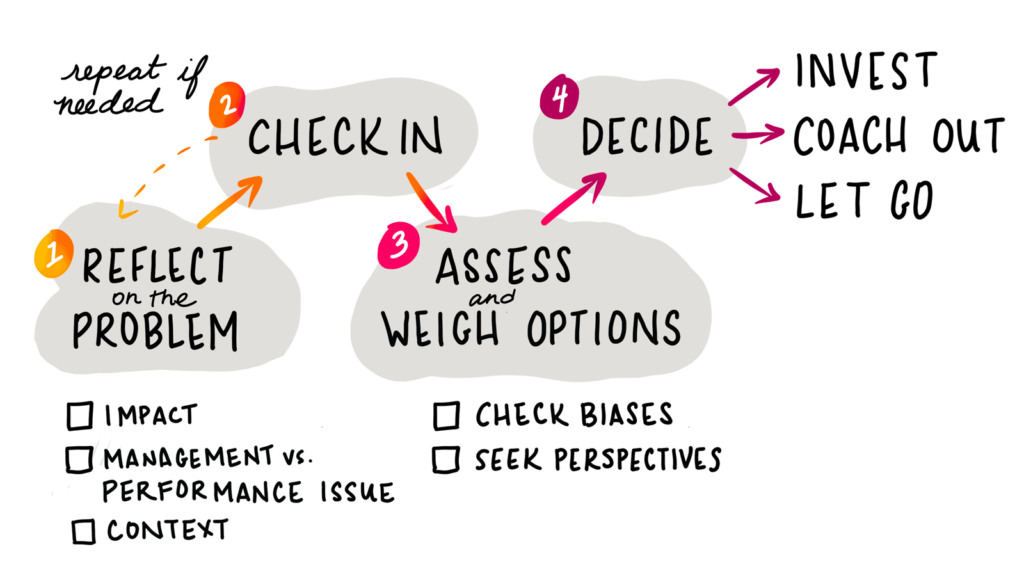The following is a case study that illustrates the four steps outlined in our article on addressing performance problems.
Imagine that your development manager has completed the last two grant reports late, leaving you little time to review, and even missed a deadline by two days. The last few months have been your team’s busy season. The development manager has been on staff for two years. Prior to the last two months, their performance has been solid, with a few blips here and there that were quickly addressed. What do you do next?

1. Reflect
First, you start by considering your sphere of control. Perhaps you’ve been serving on the interview committee for a hiring process and you had to cancel several check-ins over the last two months to schedule interviews. These check-ins would have been times you would have been able to offer support, share feedback on drafts, and workshop problems together. In your self-reflection, you can see that your decision to cancel check-ins contributed to their feeling a lack of support.
At the same time, a few canceled check-ins likely were not the sole reason for your development manager missing deadlines. One of the competencies outlined in their role expectations sheet is to be able to drive multiple, simultaneous projects with few dropped balls, including during the development team’s busy season. And, you have a team norm that if a deadline has to be missed, it should be communicated well in advance—you didn’t find out about the latest missed deadline until after the fact. Your additional support may have mitigated the situation, but both of these things are their responsibility.
2. Check in
At your next check-in, you dedicate some time to discussing what you’ve observed using CSAW. You start by telling them that you have some feedback to share and that you want to better understand what’s happening from their perspective. They listen to your observations, but you sense some defensiveness. You ask, “What was your experience of the last grant reporting project? What am I missing?”
They share that they feel a need for more staffing—both throughout the organization and on the development team specifically. They also feel the increase in staff turnover and slowed hiring during their team’s busy season has impacted their productivity and that of others. Lastly, they admit that they have been a little distracted—they’ve been organizing with a local Southeast Asian anti-deportation coalition and recently lost a campaign, resulting in the deportation of a beloved community member.
At the end of the conversation, you better understand where they’re coming from and have gained new information to inform your next steps. They left with an understanding of how their missed deadlines and lack of communication impacted the team and the work. You both agree that something needs to change moving forward. You set up a time to check in again after you both reflect on your conversation.
3. Assess
After your conversation, you step back and revisit the problem. According to your assessment, the real problem is that they needed additional support to meet their deadlines, but they didn’t communicate the need until it was too late. You weren’t as available as you could have been and took their silence to mean that they had it covered. You understand and agree that there’s a lot going on, both within the organization and in the development manager’s life.
4. Consider and decide
Upon assessing the problem, you believe that investment is the best option. You decide to follow up in your next check-in to dig in more about the communications issues, reset expectations, and let them know what you’ll commit to (weekly check-ins to offer troubleshooting support and coaching) moving forward. You also reiterate the importance of deadlines—especially external ones—and communicating about them. Given their track record of success at the organization, you let them know you’re hopeful that the problem won’t become a pattern. You end by setting a time to check in on the issue, reflect on progress, and give/receive feedback.
Note: If the problem does become a pattern, you would have additional conversations and take a progressive approach to formalizing corrective feedback (including a PIP and a formal written warning). You’d make sure to let the staff member know the steps you will take before they happen.